What are you taking a picture of that for?
December 11, 2015

Anti-mediocrity Campaign Part II
Sid Fletcher’s long fascination with social history, architecture and brutalism has been his inspiration to create bleak landscapes of industrial decay, high-rise blocks and deck access estates. He calls his work Tower Block Metal and an exhibition of his work ‘What Are You Taking A Picture Of That For?’ is running at The White Lion on Chesterfield Road until 20th December. Here, Sid writes about the beginnings of Tower Block Metal.
The name Tower Block Metal was originally conjured up back in the heady times of the late ’80s when I was in a metal/ punk group along with some mates back in Rochdale. Metal at that point was constantly being classified into subgenres and so we (jokingly) called our particular brand Tower Block Metal. Written by disaffected young men in a large Northern town towards the end of Thatcher’s reign, the music was naturally quite aggressive, the majority of the lyrics being about alienation, marginalisation and many other societal problems. It was all sung along on the backdrop of quite crude and elementary heavy metal.
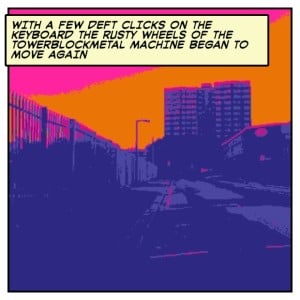 The term has always stuck with me really. When I started to become more serious about producing my artwork I really wanted to avoid something like Urban Prints by Sid Fletcher or Sid’s Tower Block page. I read an article about what to call your shop or webpage and one piece of advice that resonated with me was to take two random things that you really like and stick them together – I’ve always liked the imagery of Tower Blocks and I like Metal! That clinched it really.
The term has always stuck with me really. When I started to become more serious about producing my artwork I really wanted to avoid something like Urban Prints by Sid Fletcher or Sid’s Tower Block page. I read an article about what to call your shop or webpage and one piece of advice that resonated with me was to take two random things that you really like and stick them together – I’ve always liked the imagery of Tower Blocks and I like Metal! That clinched it really.
I remember as a child seeing Le Corbusier’s drawings and sketches re-housing 3 million people in a city of the future with its large block for commerce and different districts or zones for industry, leisure, housing etc. I was blown away!
From that early age I’ve always been interested in post war developments and town planning such as the newer modernist or brutalist estates with their walkways and ramps, transport interchanges, ring roads, precincts and civic buildings. How they were all planned to work cohesively together represents to me the utopian ideals of the time and the vanguard of young planners who I seriously believe were trying to make a better and more futuristic world. Aesthetically I do love Modernism and Brutalism: clean lines, functionality and the use of basic materials. I am somewhat of a utilitarian person.
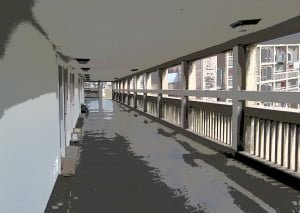
Park Hill Grey Corridor
When it comes to blocks of flats I like the relentless repetition of units and fenestration and the element of habitation makes each unit paradoxically unique as opposed to just looking at a skyscraper or office block, which is just relentless. Also, commercial or corporate buildings tend to be cleaner and well maintained, unlike flats, which generally have more grime on them, making them more fascinating to capture.
If I do include people in my work they tend to be solitary or vulnerable as if the scale and content of the image dominates the person but still makes them somewhat significant.
Back in the day I pasted lots of black and white photocopies together to make my own dystopian cityscapes – they usually ended up as mix tape covers for mates.
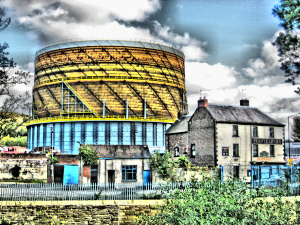
Now, my work usually begins life as a photograph or sometimes a photomontage. I then work with it digitally cutting out some bits and pasting in other bits and then add in lots of effect and/or colours sometimes in blocks, sometimes as highlights. Most of my work oscillates from pure monochrome to hyper-dynamic colour. The idea being to make the end piece incredibly intense and powerful and as far as possible from a photo. In artistic terms I have little if any time for mediocrity, subtlety or safe/middle of the roadness and I’d like to think my work reflects that.
It was Jonathan Wilkinson’s (WeLiveHere) earlier work that was really inspirational for me six or seven years ago; a licence to say it’s ok to celebrate this heritage, you are not alone! You have to remember that up until then, there was very little artwork depicting this sort of architecture.
I think there was somewhat of a collective turning point then following the demolition of Tinsley Cooling Towers and the sudden realisation that within a matter of seconds something that has been there all your life is eradicated forever.
You may have seen Sid’s work in: Frankly My Deer, The Corner Gallery and MoonKo, all in Sheffield. He’s also had his work exhibited at the Urban Outfitters in Manchester and London. Recently he was requested to provide an exclusive limited edition as a welcome present to the commercial clients moving into Park Hill which he is rightly quite chuffed about!
Jon and Mandy at the White Lion hope to hosting more exhibitions of local artists’ work and Sid is most grateful for being asked to present their inaugural one. Find out more about Sid at http://www.towerblockmetal.co.uk.

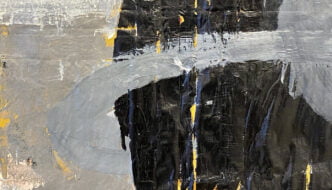
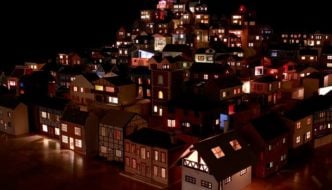

Comments